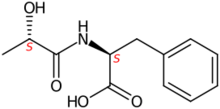Chemistry:Lac-Phe

| |
| Names | |
|---|---|
| IUPAC name
(2S)-2-[[(2S)-2-hydroxypropanoyl]amino]-3-phenylpropanoic acid
| |
| Other names
N-[(S)-lactoyl]-L-phenylalaninate
N-Lactoyl-phenylalanine N-Lactoylphenylalanine | |
| Identifiers | |
3D model (JSmol)
|
|
| ChEBI | |
| ChemSpider | |
PubChem CID
|
|
| |
| |
| Properties | |
| C12H15NO4 | |
| Molar mass | 237.255 g·mol−1 |
| Related compounds | |
Related N-acyl-alpha-amino acids
|
N-Acetylaspartic acid N-acetylcysteine N-Acetylglutamic acid N-Acetylglutamine N-Acetylleucine N-formylmethionine |
Related compounds
|
Lactamide |
Except where otherwise noted, data are given for materials in their standard state (at 25 °C [77 °F], 100 kPa). | |
| Infobox references | |
Lactoylphenylalanine, or Lac-Phe, is a metabolite generated by intense exercise.[1][2][3] In mice, high levels of Lac-Phe in the blood cause a decrease of food intake[1] and in humans, its production has been shown to correlate with adipose tissue loss during an endurance exercise intervention.[4] In mammals it is created from (S)-lactate and L-phenylalanine by the cytosol nonspecific dipeptidase (CNDP2) protein.[5] It is classified as N-acyl-alpha-amino acid and pseudodipeptide.[6]
It has also been reported that as an additive N-L-lactoyl phenylalanine improves the taste of food, conferring an umami flavor. It is found naturally in significant amounts in some traditional Chinese fermented foods such as preserved pickles and soy sauce.[7] Oral intake of Lac-Phe does not have anti-obesity effects in mice.[1]
See also
- Acyl group
- Lactoyl, the acyl group derived from lactic acid
- Alpha-amino acid
- Dipeptide
- Dipeptidase
References
- ↑ 1.0 1.1 1.2 "An exercise-inducible metabolite that suppresses feeding and obesity". Nature 606 (7915): 785–790. June 2022. doi:10.1038/s41586-022-04828-5. PMID 35705806. Bibcode: 2022Natur.606..785L.
- ↑ "Appetite-suppressing molecule helps obese mice lose weight". New Scientist. 15 June 2022. https://www.newscientist.com/article/2324591-appetite-suppressing-molecule-helps-obese-mice-lose-weight/.
- ↑ "Why Does a Hard Workout Make You Less Hungry?". The New York Times. 15 June 2022. https://www.nytimes.com/2022/06/15/well/move/exercise-appetite.html.
- ↑ "Exercise-Induced N-Lactoylphenylalanine Predicts Adipose Tissue Loss during Endurance Training in Overweight and Obese Humans". Metabolites 13 (1): 15. January 2023. doi:10.3390/metabo13010015. PMID 36676940.
- ↑ "N-lactoyl-amino acids are ubiquitous metabolites that originate from CNDP2-mediated reverse proteolysis of lactate and amino acids". Proceedings of the National Academy of Sciences of the United States of America 112 (21): 6601–6606. May 2015. doi:10.1073/pnas.1424638112. PMID 25964343. Bibcode: 2015PNAS..112.6601J.
- ↑ "Metabocard for N-Lactoylphenylalanine". The Human Metabolome Database (HMDB). The Metabolomics Innovation Centre (TIMC). https://hmdb.ca/metabolites/HMDB0062175.
- ↑ "Preparation and Taste Characteristics of Kokumi N-Lactoyl Phenylalanine in the Presence of Phenylalanine and Lactate". Journal of Agricultural and Food Chemistry 70 (17): 5396–5407. May 2022. doi:10.1021/acs.jafc.2c00530. PMID 35452224.
External links
- Lowe, Derek. "A Metabolite of Exercise" (in en). https://www.science.org/content/blog-post/metabolite-exercise.
 |

